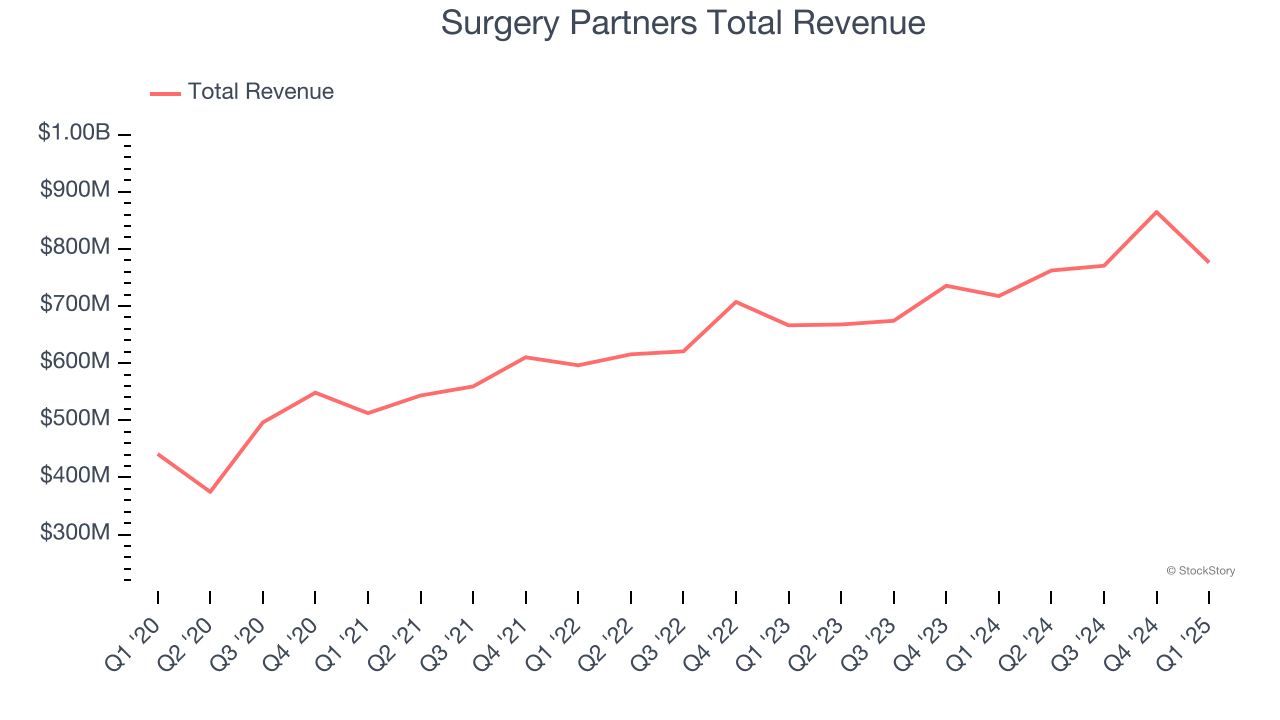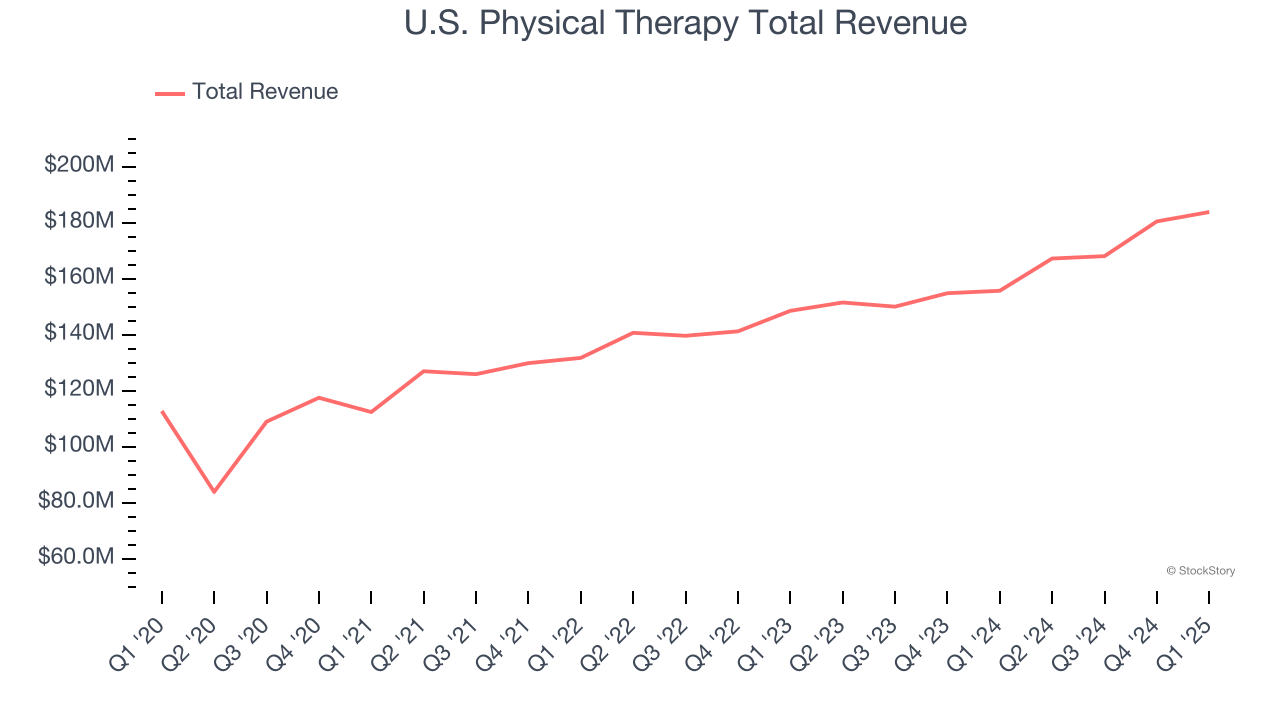
Let’s dig into the relative performance of Surgery Partners (NASDAQ:SGRY) and its peers as we unravel the now-completed Q1 outpatient & specialty care earnings season.
The outpatient and specialty care industry delivers targeted medical services in non-hospital settings that are often cost-effective compared to inpatient alternatives. This means that they are more desired as rising healthcare costs and ways to combat them become more and more top-of-mind. Outpatient and specialty care providers boast revenue streams that are stable due to the recurring nature of treatment for chronic conditions and long-term patient relationships. However, their reliance on government reimbursement programs like Medicare means stroke-of-the-pen risk. Additionally, scaling a network of facilities can be capital-intensive with uneven return profiles amid competition from integrated healthcare systems. Looking ahead, the industry is positioned to grow as demand for outpatient services expands, driven by aging populations, a rising prevalence of chronic diseases, and a shift toward value-based care models. Tailwinds include advancements in medical technology that support more complex procedures in outpatient settings and the increasing focus on preventive care, which can be aided by data and AI. However, headwinds such as reimbursement rate cuts, labor shortages, and the financial strain of digitization may temper growth.
The 7 outpatient & specialty care stocks we track reported a mixed Q1. As a group, revenues beat analysts’ consensus estimates by 0.7% while next quarter’s revenue guidance was 0.8% below.
Amidst this news, share prices of the companies have had a rough stretch. On average, they are down 5.7% since the latest earnings results.
Surgery Partners (NASDAQ:SGRY)
With more than 180 locations across 33 states serving as alternatives to traditional hospital settings, Surgery Partners (NASDAQ:SGRY) operates a national network of outpatient surgical facilities including ambulatory surgery centers and short-stay surgical hospitals.
Surgery Partners reported revenues of $776 million, up 8.2% year on year. This print was in line with analysts’ expectations, but overall, it was a slower quarter for the company with a significant miss of analysts’ EPS estimates.
Eric Evans, Chief Executive Officer, stated, “I am pleased with our strong start to 2025, as the Company continues to deliver growth that is consistent with Surgery Partners’ long-term growth algorithm. Our continued focus on maximizing portfolio performance, advancing a robust M&A pipeline and driving greater operating efficiencies, combined with a bullish outlook on surgical trends and the regulatory landscape, have us positioned to continue delivering industry leading earnings growth in 2025 and beyond.”

Interestingly, the stock is up 6.6% since reporting and currently trades at $23.60.
Read our full report on Surgery Partners here, it’s free.
Best Q1: U.S. Physical Therapy (NYSE:USPH)
With a nationwide footprint spanning 671 clinics across 42 states, U.S. Physical Therapy (NYSE:USPH) operates a network of outpatient physical therapy clinics and provides industrial injury prevention services to employers across the United States.
U.S. Physical Therapy reported revenues of $183.8 million, up 18.1% year on year, outperforming analysts’ expectations by 4.4%. The business had an exceptional quarter with a solid beat of analysts’ sales volume estimates and a decent beat of analysts’ EPS estimates.

U.S. Physical Therapy pulled off the biggest analyst estimates beat and fastest revenue growth among its peers. The market seems happy with the results as the stock is up 12.5% since reporting. It currently trades at $79.71.
Is now the time to buy U.S. Physical Therapy? Access our full analysis of the earnings results here, it’s free.
Weakest Q1: Select Medical (NYSE:SEM)
With a nationwide network spanning 46 states and over 2,700 healthcare facilities, Select Medical (NYSE:SEM) operates critical illness recovery hospitals, rehabilitation hospitals, outpatient rehabilitation clinics, and occupational health centers across the United States.
Select Medical reported revenues of $1.35 billion, up 2.4% year on year, falling short of analysts’ expectations by 2.6%. It was a softer quarter as it posted a significant miss of analysts’ EPS estimates and full-year revenue guidance missing analysts’ expectations.
Select Medical delivered the weakest performance against analyst estimates and weakest full-year guidance update in the group. As expected, the stock is down 16.6% since the results and currently trades at $15.20.
Read our full analysis of Select Medical’s results here.
LifeStance Health Group (NASDAQ:LFST)
With over 6,600 licensed mental health professionals treating more than 880,000 patients annually, LifeStance Health (NASDAQ:LFST) provides outpatient mental health services through a network of clinicians offering psychiatric evaluations, psychological testing, and therapy across 33 states.
LifeStance Health Group reported revenues of $333 million, up 10.8% year on year. This result met analysts’ expectations. Aside from that, it was a mixed quarter as it also recorded an impressive beat of analysts’ EPS estimates but EBITDA guidance for next quarter missing analysts’ expectations significantly.
The stock is down 14.5% since reporting and currently trades at $5.60.
Read our full, actionable report on LifeStance Health Group here, it’s free.
DaVita (NYSE:DVA)
With over 2,600 dialysis centers across the United States and a presence in 13 countries, DaVita (NYSE:DVA) operates a network of dialysis centers providing treatment and care for patients with chronic kidney disease and end-stage kidney disease.
DaVita reported revenues of $3.22 billion, up 5% year on year. This number topped analysts’ expectations by 0.5%. Zooming out, it was a slower quarter as it produced a significant miss of analysts’ full-year EPS guidance estimates and a slight miss of analysts’ sales volume estimates.
The stock is flat since reporting and currently trades at $145.41.
Read our full, actionable report on DaVita here, it’s free.
Market Update
Thanks to the Fed’s rate hikes in 2022 and 2023, inflation has been on a steady path downward, easing back toward that 2% sweet spot. Fortunately (miraculously to some), all this tightening didn’t send the economy tumbling into a recession, so here we are, cautiously celebrating a soft landing. The cherry on top? Recent rate cuts (half a point in September 2024, a quarter in November) have propped up markets, especially after Trump’s November win lit a fire under major indices and sent them to all-time highs. However, there’s still plenty to ponder — tariffs, corporate tax cuts, and what 2025 might hold for the economy.
Want to invest in winners with rock-solid fundamentals? Check out our Top 5 Quality Compounder Stocks and add them to your watchlist. These companies are poised for growth regardless of the political or macroeconomic climate.
Join Paid Stock Investor Research
Help us make StockStory more helpful to investors like yourself. Join our paid user research session and receive a $50 Amazon gift card for your opinions. Sign up here.
